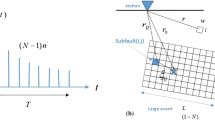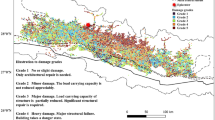Abstract
The West Asian region is an active area of crustal deformation where many historically huge earthquakes have occurred and crustal movement has continued up to the present. The severe Crete earthquake of the fourth century produced a huge tsunami that caused heavy damage throughout the Mediterranean region. This paper attempts to reproduce the ground motions of the 365 Crete earthquake by using stochastic Green’s function method with realistic phases information from observed waveforms of 2013 Crete Island earthquake (Mw 6.4) and its aftershock.
Access this chapter
Tax calculation will be finalised at checkout
Purchases are for personal use only
Similar content being viewed by others
References
Ambraseys, N.N., C.P. Melville, and R.D. Adams. 1994. The seismicity of Egypt, Arabia and the Red Sea. Cambridge, MA: Cambridge University Press.
Fischer, K.D. 2007. Modelling the 365 AD Crete earthquake and its tsunami. Geophysical Research Abstracts 9, 09458.
Flemming, N. C. 1978. Holocene eustatic changes and coastal tectonics in the northeast Mediterranean: Implications for models of crustal consumption. Philosophical Transaction of the Royal Society London, Series A 289 (1362): 405–458 + Appendix I.
Hori, T., and Y. Kaneda. 2013. Giant earthquakes and tsunamis in the world: Mediterranean Sea. Report of CCEP 89.
Kanamori, H. 1977. The energy release in great earthquakes. Journal of Geophysical Research 82: 2981–2987.
Karagianni, E.E. 2005. Shear velocity structure in the Aegean area obtained by inversion of Rayleigh waves. Geophysical Journal International 160(1): 127–143.
Murotani, S., K. Satake, and Y. Fujii. 2013. Scaling relations of seismic moment, rupture area, average slip, and asperity size for M ~ 9 subduction-zone earthquakes. Geophysical Reserarch Letters 40(19): 5070–5074.
Okada, Y. 1992. Internal deformation due to shear and tensile faults in a half-space. Bulletin of the Seismological Society of America 82: 1018–1040.
Papadimitriou, E., and V. Karakostas. 2008. Rupture model of the great AD 365 Crete earthquake in the south-western part of the Hellenic Arc. Acta Geophysica 56(2): 293–312.
Papazachos, B.C., B.G. Karakostas, C.B. Papazachos, and E.M. Scordilis. 2000. The geometry of the Benioff zone and lithospheric kinematics in the Hellenic arc. Tectonophysics 319: 275–300.
Papazachos, B.C., D.M. Mountrakis, C.B. Papazachos, M.D. Tranos, G.F. Karakaisis, and A.S. Savvaidis. 2001. The faults that caused the known strong earthquakes in Greece and surrounding areas during 5th century B.C. up to present. In Proceedings of the 2nd Conference on Earthquake Engineering and Engineering Seismic, 28–30 September 2001, Thessaloniki 1, 17–26
Pirazzoli, P.A. 1986. The early Byzantine tectonic paroxysm. Z. Geomorph. N.F., Suppl.-Bd 62: 31–49.
Pirazzoli, P.A., J. Thommeret, Y. Thommeret, J. Laborel, and L.F. Montaggioni. 1982. Crustal block movements from holocene shorelines: Crete and Antikythira (Greece). Tectonophysics 86: 27–43.
Pirazzoli, P.A., J. Laborel, and S.C. Stiros. 1996. Earthquake clustering in the eastern Mediterranean during historical times. Journal of Geophysical Research 101(B3): 6083–6097, Solid earth.
Ruff, L., and H. Kanamori. 1980. Seismicity and the subduction process. Physics of the Earth and Planetary Interiors 23: 240–252.
Schellart, W.P., and N. Rawlinson. 2010. Convergent plate margin dynamics: New perspectives from structural geology, geophysics and geodynamic modelling. Tectonophysics 483: 4–19.
Shaw, B., N. Ambraseys, P.C. England, M.A. Floyd, G.J. Gorman, T.F.G. Higham, J.A. Jackson, J.-M. Nocquet, C.C. Pain, and M.D. Piggott. 2008. Eastern Mediterranean tectonics and tsunami hazard inferred from the AD365 earthquake. Nature Geoscience 1: 268–276.
Sieberg, A. 1932. Isoseismal contours crete ad 365 crete earthquake intensity isoseismal contours crete, Untersuchungen uber Erdbeben und Bruchschollenbau im Oestlichen Mittelmeergebiet, Jena: [s.n.], BA49737430.
Stiros, S.C. 1996. Late holocene relative sea level changes in SW Crete: Evidence of an unusual earthquake cycle. Annali di Geofisica 39(3): 677–687.
Stiros, S.C. 2010. The 8.5+ magnitude, AD365 earthquake in Crete: Coastal uplift, topography changes, archaeological and historical signature. Quaternary International 216: 54–63.
Thommeret, Y., J. Thommeret, P.A. Pirazzoli, L.F. Montaggioni, and J. Laborel. 1981. Nouvelles donnees sur les rivages souleves de I’Holocene dans l’ouest de la Crete. Oceanis 7(4): 473–480.
Wyss, M., and M. Baer. 1981. Earthquake hazard in the Hellenic Arc. Maurice Ewing Series 4: 153–172.
Acknowledgments
The authors acknowledge the kind help during their reconnaissance given by Professor Gerassimos A. Papadopoulos, Institute of Geodynamics National Observatory of Athens, who provided the authors with important shear velocity structures in the Aegean area. The authors are indebted to Professor Eleftheria Papadimitriou and Associate Professor Vassilis Karakostas, Aristotele University of Thessaloniki, who provided the authors with important waveform data obtained from Crete Island.
The authors were provided with important information and constructive comments for the stochastic Green’s function method by Mr. Yasuhiro Fukushima, Eight-Japan Engineering Consultants Inc.
Author information
Authors and Affiliations
Corresponding author
Editor information
Editors and Affiliations
Rights and permissions
Copyright information
© 2017 Springer Science+Business Media Singapore
About this chapter
Cite this chapter
Ohsumi, T., Yagi, Y. (2017). Earthquake Activity in West Asia: Seismicity in the Mediterranean Sea and Evaluation of the Strong Motion for the AD 365 Crete Earthquake Using the Stochastic Green’s Function. In: Tsuneki, A., Yamada, S., Hisada, Ki. (eds) Ancient West Asian Civilization. Springer, Singapore. https://doi.org/10.1007/978-981-10-0554-1_5
Download citation
DOI: https://doi.org/10.1007/978-981-10-0554-1_5
Published:
Publisher Name: Springer, Singapore
Print ISBN: 978-981-10-0553-4
Online ISBN: 978-981-10-0554-1
eBook Packages: Social SciencesSocial Sciences (R0)




